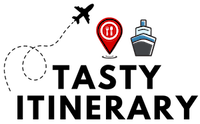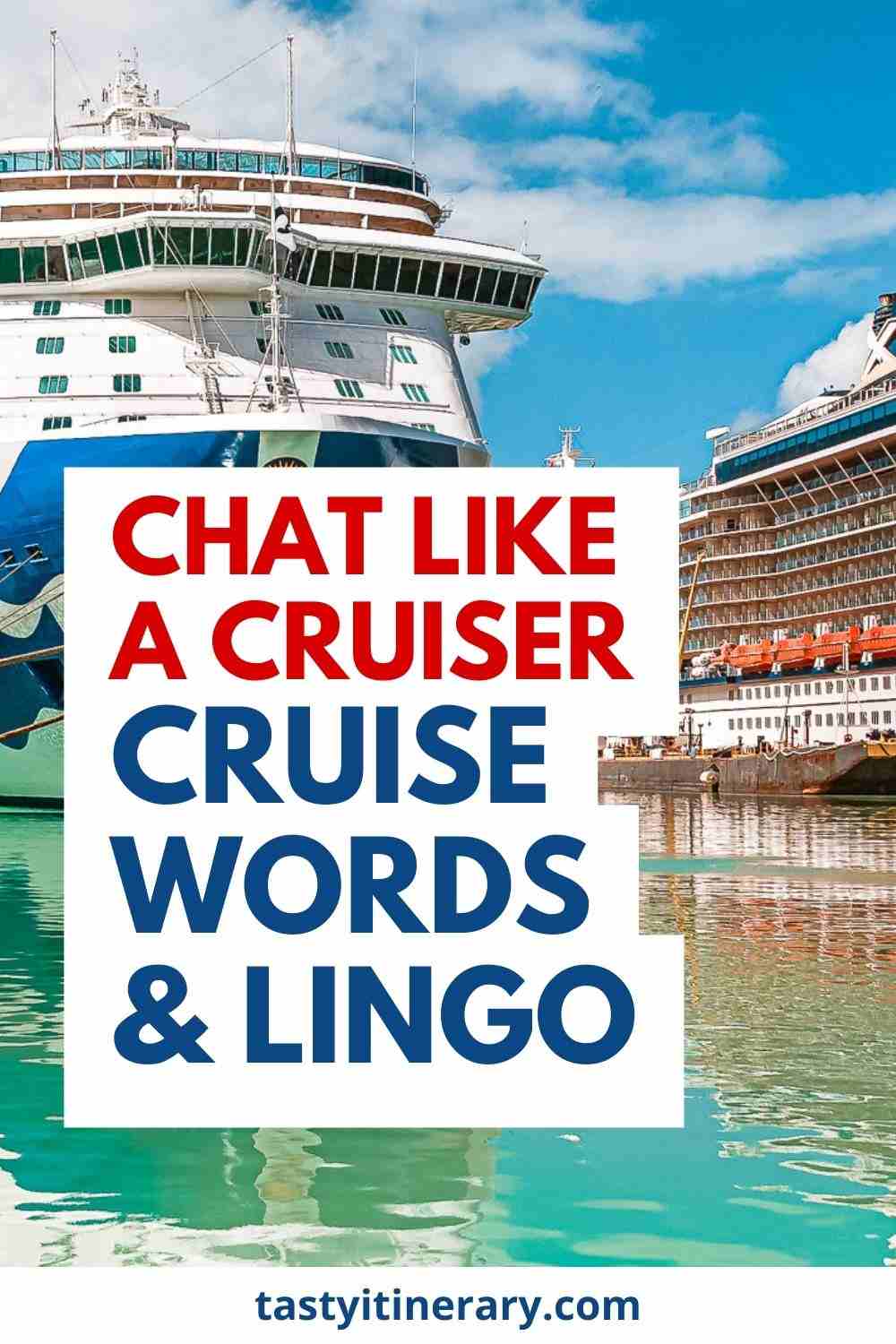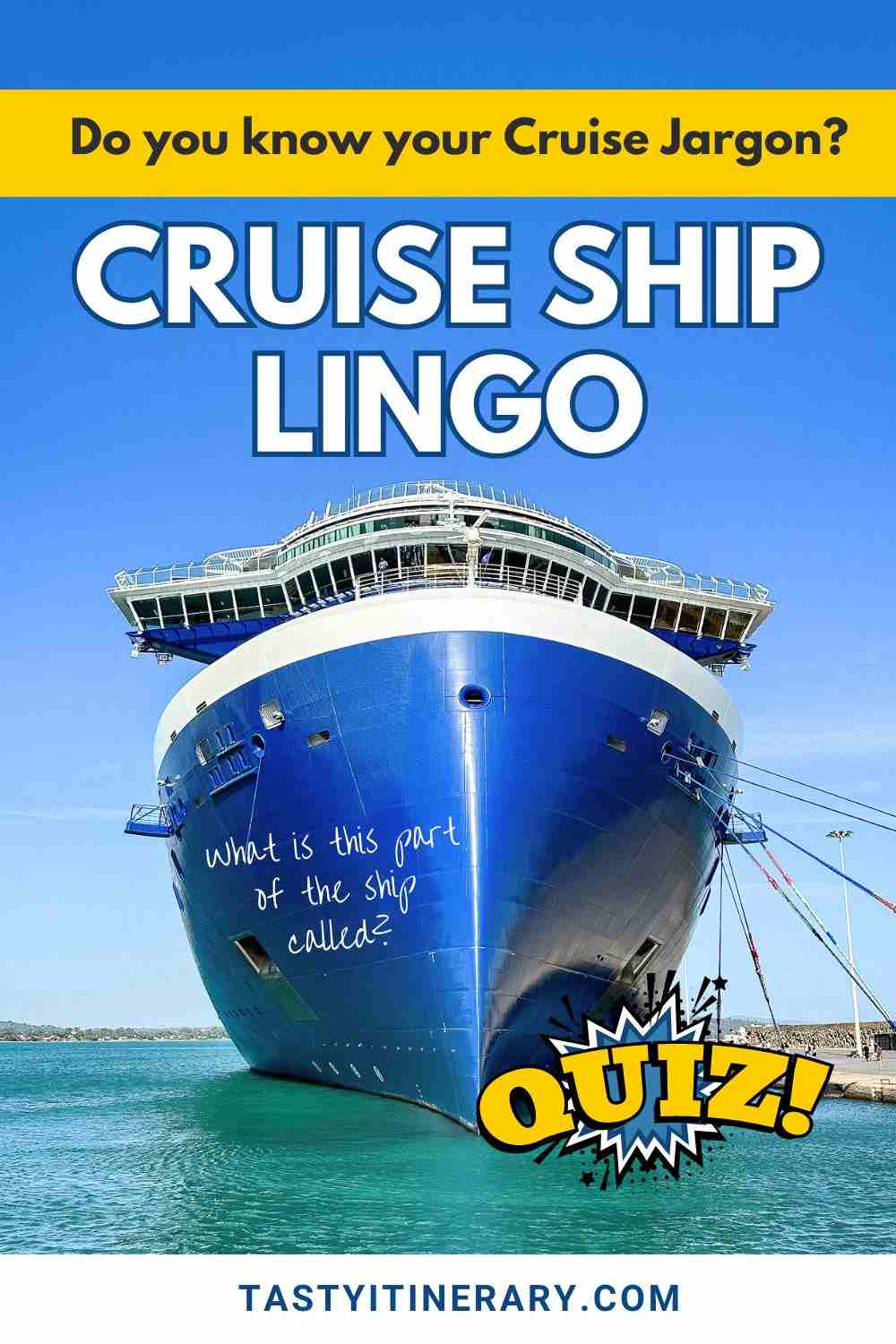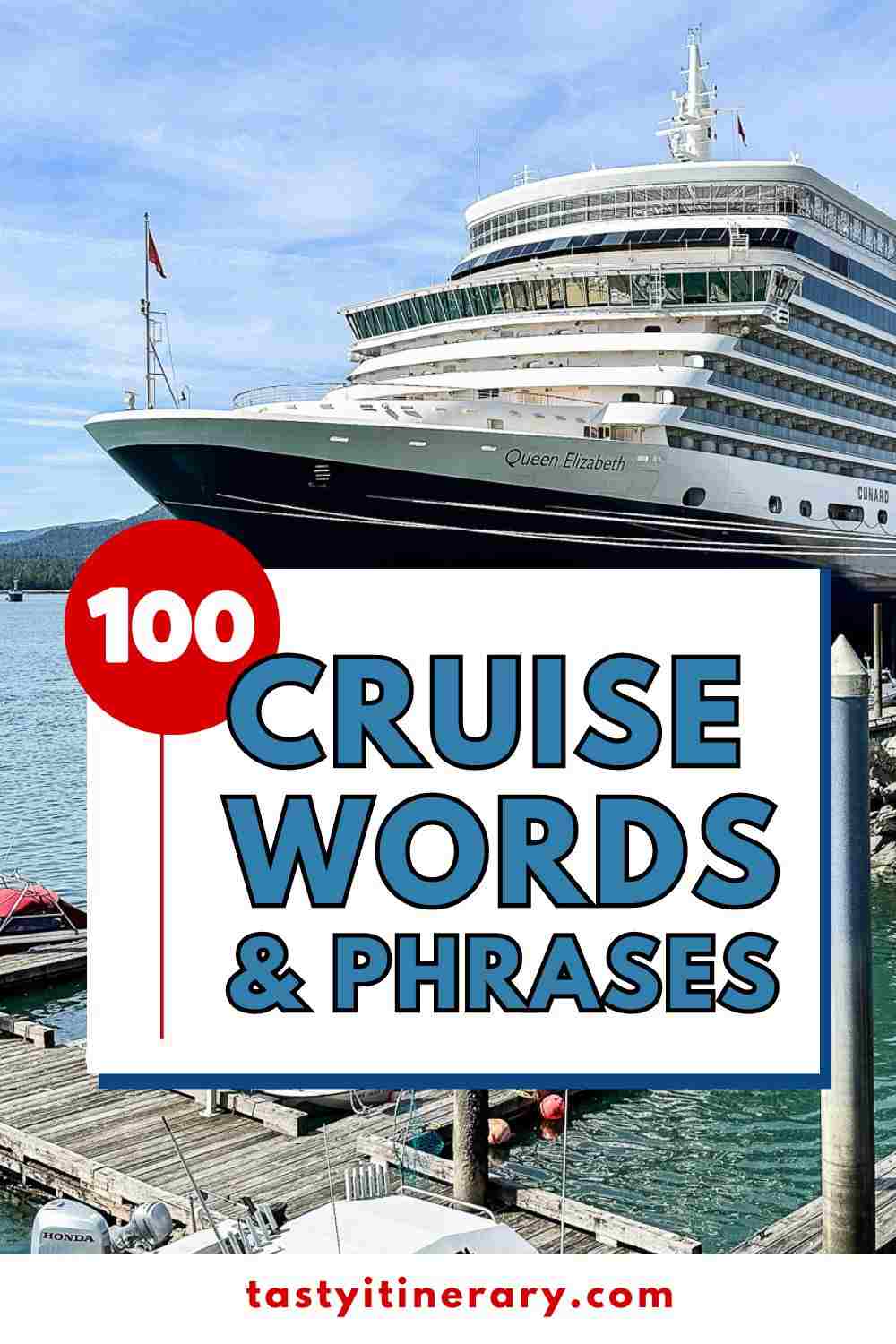Understanding Cruise Words and Lingo To Chat Like a Cruiser
As you start planning your cruise, you’ll quickly realize there’s a world of cruise words to familiarize yourself with. Some cruise ship lingo might be straightforward, but others could have you scratching your head in confusion. Fear not—we’re here to demystify the jargon for you and quiz you for fun.
Soon, you’ll be chatting like a seasoned cruiser, effortlessly tossing around terms like “port” and “starboard,” “aft” and “bow,” along with “gangway” and “lido deck.” You’ll confidently navigate the ship, knowing your “muster station” from your “tender port” with the ease of a seasoned cruiser.
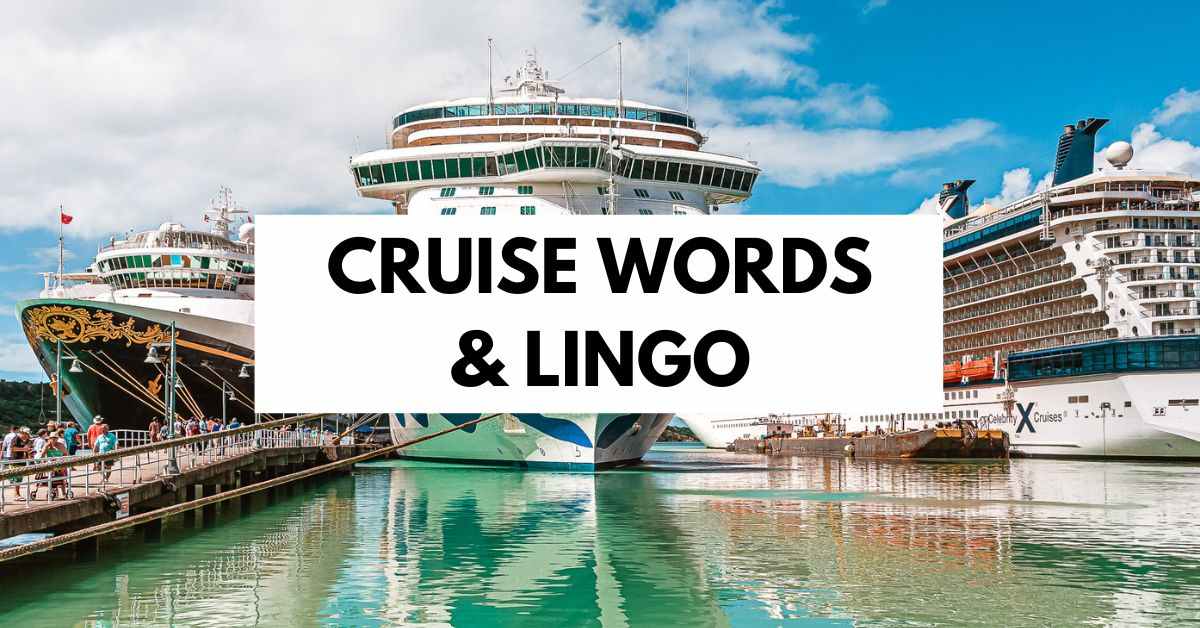
We won’t get into cruise vocabulary you may never need to know or use. We’ll stick to cruise ship terms you’ll find the most useful to understand. For fun, we’ve added a quiz below.
The most important cruise word you should remember is SHIP. It’s a SHIP, NOT a boat.
Cruise Words and Its Definitions
Fundamental Cruise Ship Lingo You Should Know From the Start
Let’s start with the basic cruise terms. Familiarize yourself with these keywords to lay the groundwork for your cruise lingo education. You’ll be coming across them frequently as you navigate the planning process.
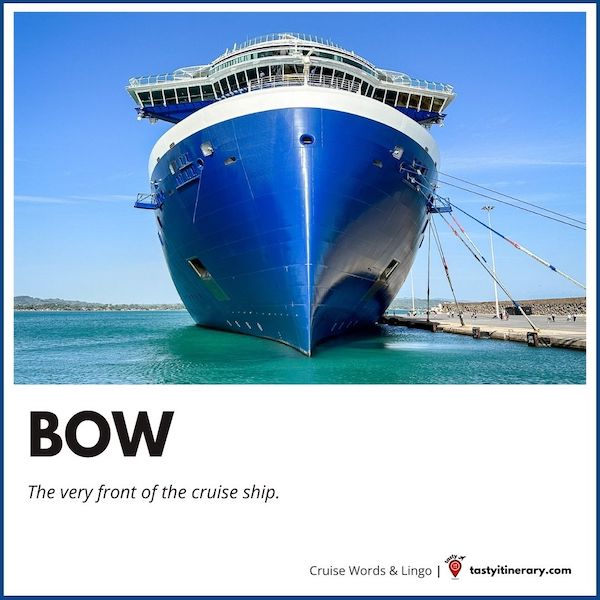
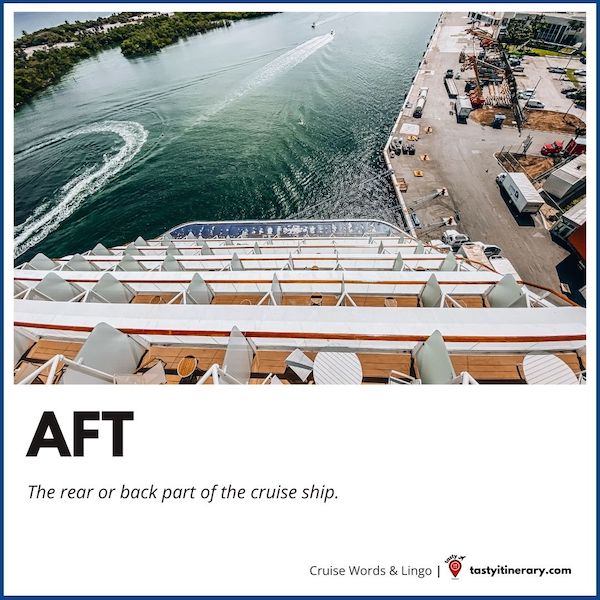
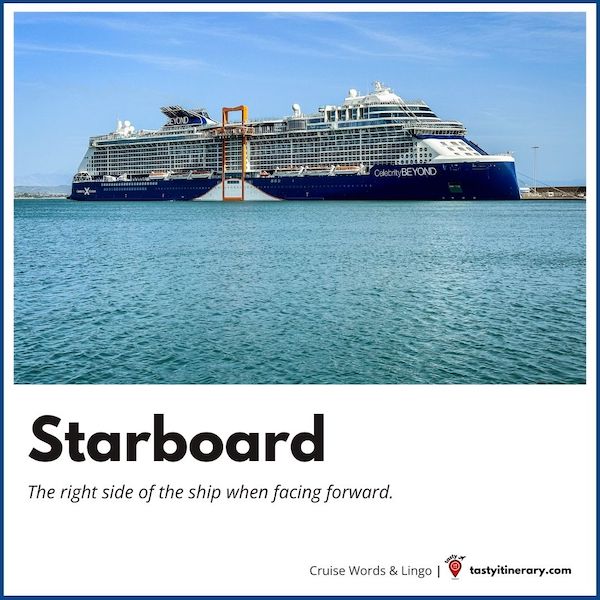
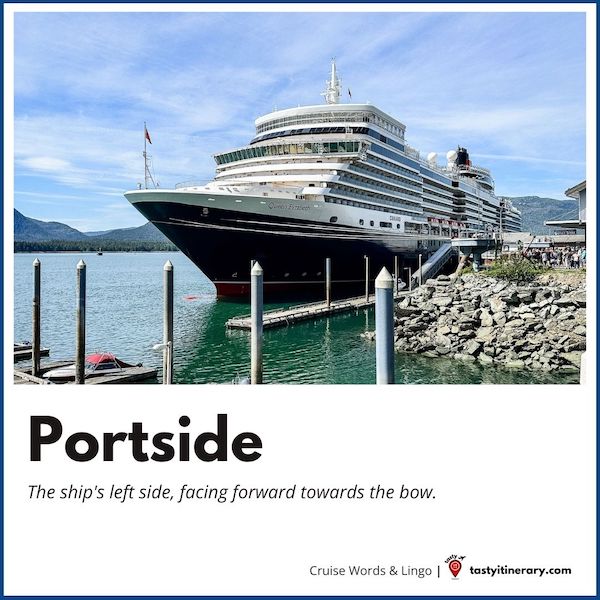
- Ship: a vessel designed for maritime navigation across oceans and large bodies of water, capable of carrying people and cargo long distances. You can fit boats inside a ship, but not vice versa.
- Bow: The very front of the ship.
- AFT: The rear or back part of the inside of the ship.
- Midship (MID): The middle area of the ship is often used to describe cabin locations.
- Forward (FWD): Refers to the area or direction towards the vessel’s front end.
- Portside: The ship’s left side, facing forward towards the bow.
- Starboard: The right side of the ship when facing forward.
- Port of Call: A port-of-call is a stop a cruise ship makes on its itinerary, where passengers can disembark to explore the destination. Also known as port destination.
- Tender: A small boat transporting passengers from the ship to the shore when the ship cannot dock at the port directly.
- Gangway: The entrance or exit ramp is used by passengers to board or leave the ship.
- Cabin or Stateroom: Your room on the ship can vary from interior rooms without windows to suites with large balconies.
- Sea Day: A day during the cruise when the ship does not dock at a port, allowing guests to enjoy the onboard amenities.
- Shore Excursion: Organized tours or activities in the port cities where the ship docks.
- Deck Plan: A map showing the ship’s layout, including cabins, public areas, and amenities, to help passengers navigate.
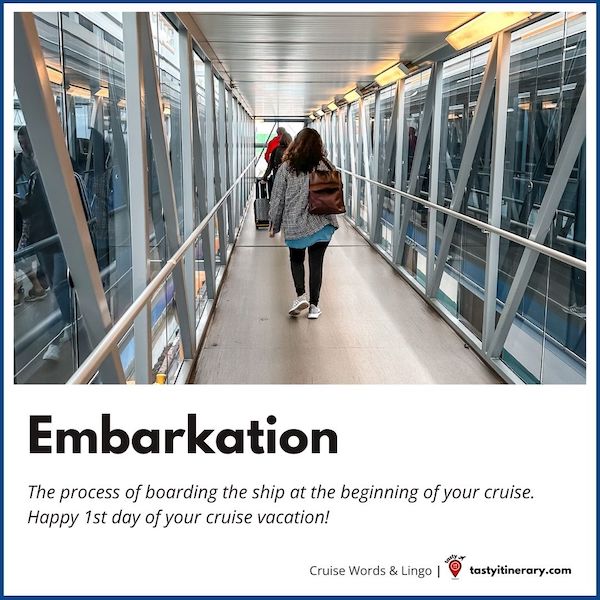
- Embarkation: The process of boarding the ship at the beginning of your cruise. You could consider it a happy day because it’s cruise vacation day #1.
- Disembarkation: The saddest day of a cruise vacation. The process of leaving the ship at the end of the cruise.
- Gangway: The entrance or exit ramp passengers use to board or leave the ship, typically when docked at a port.
- Muster Station: Previously defined, this term refers to a designated area where passengers gather during a ship’s emergency drill. Understanding your muster station is crucial for safety.
- Muster Drill: A mandatory exercise for all passengers and crew conducted at the beginning of the voyage to practice emergency procedures.
- Lifeboats: Small boats carried on the ship are used during an emergency evacuation. Knowing how to locate and access lifeboats is essential.
- Life Jackets: Personal flotation devices are provided in each cabin for every passenger. Familiarizing yourself with how to wear it correctly is a key safety measure.
- Cruise Agent: A travel professional or agency specializing in booking cruise vacations.
Other Cruising Terminology and Phrases You’ll Find Yourself Using Rather Quickly
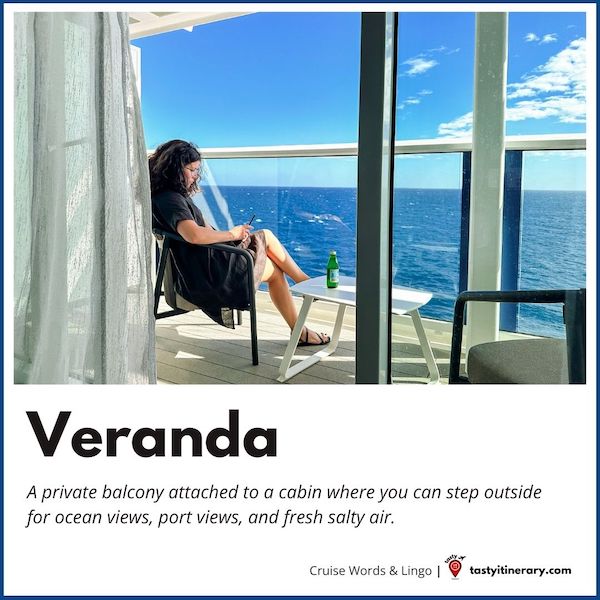
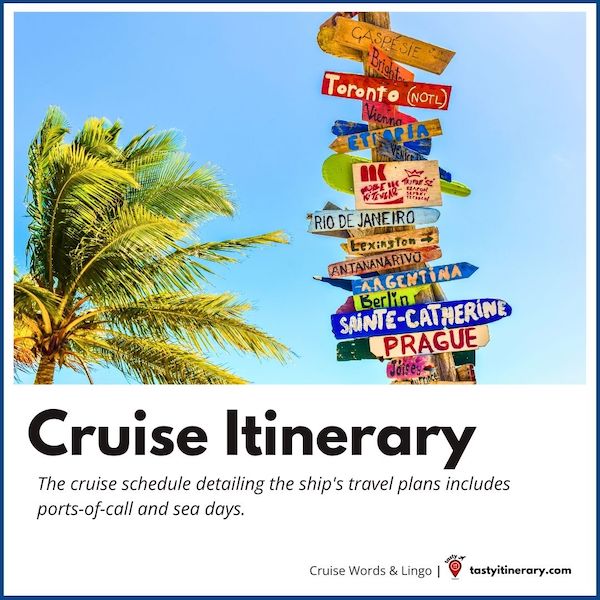
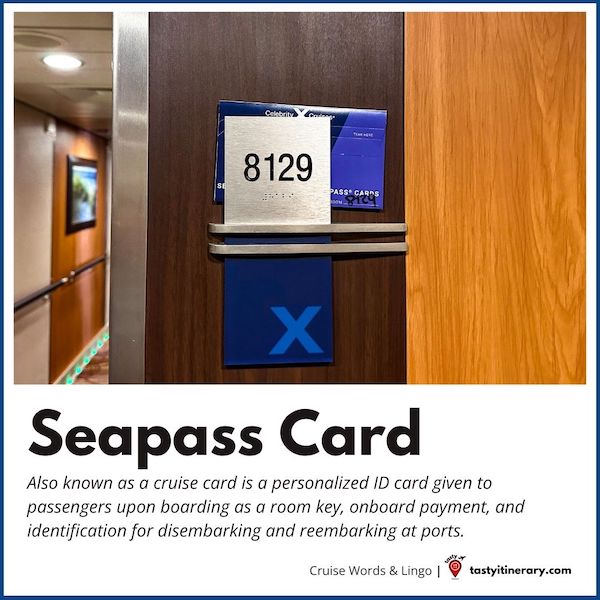
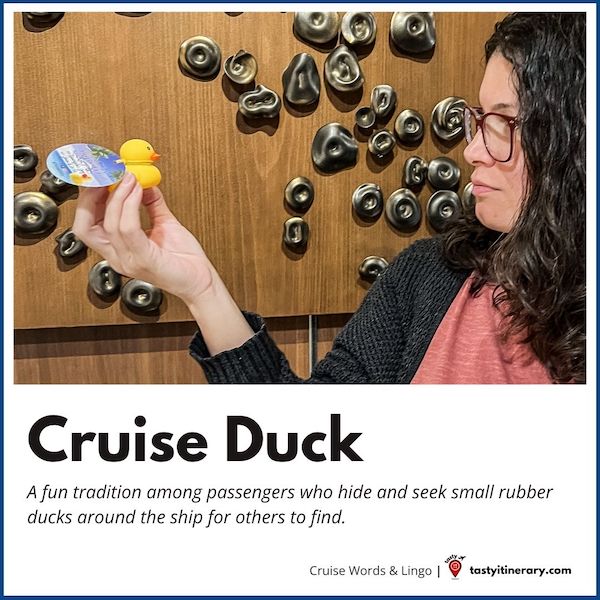
Let’s dive further into some other jargon popular in the cruise world.
- Passenger: That would be you, the cruiser, on a cruise ship.
- Cruiser: Another way to say a passenger on a cruise ship vessel.
- Seasoned Cruiser: Someone with extensive experience taking multiple cruises is familiar with the nuances of cruise travel.
- Cruise Card or Seapass Card: A personalized ID card is given to passengers upon boarding as a room key, onboard payment, and identification for disembarking and reembarking at ports.
- Cabin Category: The classification of staterooms based on size, location, and amenities, from interior cabins to luxury suites.
- Inside Cabin: A windowless cabin on the ship. Usually the most budget-friendly cabin.
- Oceanview (OV): A cabin featuring a window or porthole for ocean views.
- Veranda or Balcony: A private balcony attached to a cabin where you can step outside for ocean views, port views, and fresh salty air.
- Guaranteed Cabin (GTY): Cruise lines offer this booking option for a discounted rate where the passenger secures a cabin within a specific category or type at the time of booking. The exact cabin number is not assigned until closer to the sailing date.
- Freestyle Cruising: A flexible cruising style with no set dining times or seating arrangements and a relaxed dress code. This phrase is synonymous with Norwegian Cruise Line as the originator of freestyle cruising.
- Guest Services or Relations: The ship’s customer service desk is where passengers can inquire about accounts, lost items, and other services.
- Onboard Credit (OBC): Prepaid amount that is sometimes given to passengers by a promotion, agent, or cruise line to use onboard towards their bill.
- Gratuity: A daily tip for cruise staff, often automatically added to your onboard account, acknowledging their service.
- Itinerary: The cruise schedule detailing the ship’s travel plans includes ports-of-call and sea days.
- Sail Away Party: As the cruise sails from port on embarkation day, there is usually a huge celebration on the pool deck.
- Shore Excursion Desk: The place onboard where passengers can book and inquire about guided tours and activities at the upcoming ports of call.
- Towel Animal: The art of folding towels into various animal shapes is a fun and creative touch the cabin attendant may add to your cabin decor during turn-down service. Unfortunately, most cruise lines have stopped making towel animals, but Carnival Cruise Lines continues the tradition.
- Cruise Ducks: A fun tradition among passengers who hide and seek small rubber ducks around the ship for others to find.
- Wave Season: Refers to the time of year (usually January through March) when many people book their cruises, prompted by cold weather in the Northern Hemisphere and the cruise lines offering attractive deals and promotions.
- The Suite Life: The luxury experience of staying in a suite cabin on a cruise ship, offering VIP treatment, personalized service, and exclusive amenities.
- Back-to-Back (B2B): When you book one cruise after another on the same ship when one cruise ends and the other begins.
- Closed Loop Sailing: When a cruise starts and returns to the same port.
- Obstructed View: When lifeboats or ship structures partially block a view from a cabin, you do not get a full ocean view.
Cruise Deck Terms
- Lido Deck: Often the hub of outdoor activities on the ship, the Lido deck is where you’ll find the main pool area, sun loungers, and sometimes, outdoor bars and buffets.
- Promenade Deck: This deck usually features a wide, outdoor walking area around the ship, perfect for a stroll with ocean views. The promenade might include shops, cafes, and other social spaces.
- Sun Deck: As the name suggests, this is an open deck area designed for sunbathing, offering plenty of loungers and, often, panoramic sea views.
- Pool Deck: Similar to the Lido deck, this area is focused on the ship’s swimming pools and accompanying leisure facilities, including hot tubs and poolside bars.
- Observation Deck: Located at the top of the ship, the observation deck offers the best unobstructed views of the ocean and the ship’s surroundings, making it the perfect spot for sightseeing and photography.
- Sports Deck: Dedicated to physical activities, the sports deck may include jogging tracks, miniature golf courses, basketball courts, and other sports facilities.
- Spa Deck: Typically housing the ship’s spa and fitness center, this deck is about relaxation and rejuvenation, offering treatments, massages, and fitness classes.
- Entertainment Deck: Home to the ship’s theaters, cinemas, nightclubs, and lounges, this deck is the heart of nighttime entertainment.
Cruise Dining Phrases
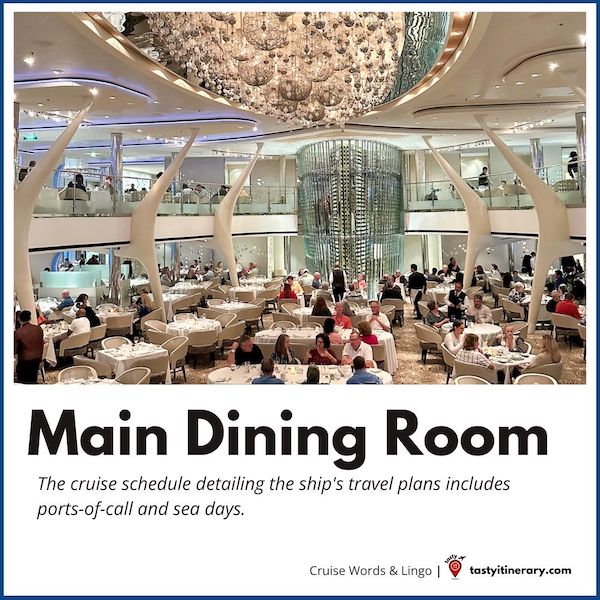
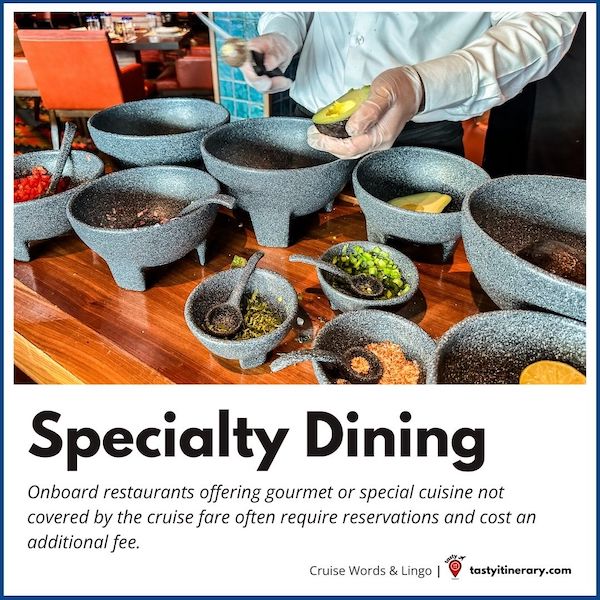
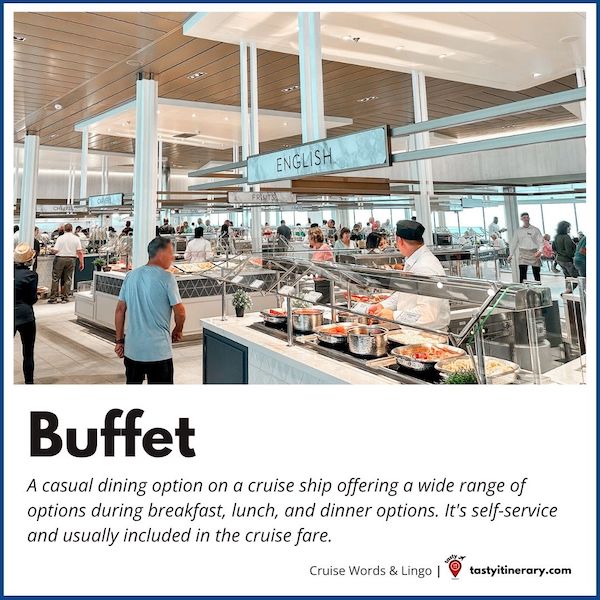
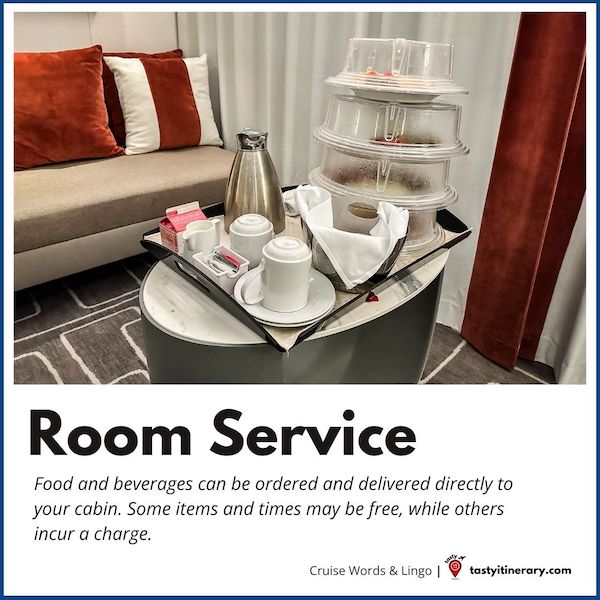
The dining experience is a large part of cruising. You should know These cruise words when delving into the dining scene on a cruise.
- Main Dining Room (MDR): The ship’s primary dining area, offering seated dining with various menu options, often included in your cruise fare. Sometimes, there is more than one main dining room.
- Buffet: A casual dining option on a cruise ship offering a wide range of options during breakfast, lunch, and dinner options. It’s self-service and usually included in the cruise fare.
- Specialty Dining: Onboard restaurants offering gourmet or special cuisine not covered by the cruise fare often require reservations and cost an additional fee.
- À la Carte: Dining options where each item is priced separately, unlike the set menu prices in the main dining room or inclusive fare at the buffet.
- Anytime Dining: Also known as “Your Time Dining” is an arrangement that allows you to eat your meals at any time during dining hours instead of scheduled seating times.
- Fixed Seating: Assigned dining times and tables for the duration of the cruise, offering a consistent dining schedule and tablemates.
- Room Service: Food and beverages can be ordered and delivered directly to your cabin. Some items and times may be free, while others incur a charge.
- Galley: The ship’s kitchen where all the food preparation happens. Some cruises offer galley tours.
- Chef’s Table: An exclusive dining experience offering a multi-course meal prepared and presented by the ship’s chef. It usually requires a reservation and an additional fee.
- Windjammer: Often the name for the buffet restaurant on Royal Caribbean cruise ships, providing various food options in a casual setting
Cruise Slang Used Regularly Amongst Cruisers
It’s not surprising that cruising has its own slang words. Whether used in a lighthearted manner or with a touch of annoyance, terms like “chair hogs” are part of the cruise community’s lexicon.
- Cruise newbies: They’re what we call first-time beginner cruises.
- Washy-washy: A fun phrase that reminds passengers to wash and disinfect their hands.
- Chair Hog: A person who gets up early to place towels or personal items on poolside loungers to “reserve” them for the entire day, often leaving them unoccupied for long periods.
- Cruise Control: A humorous term referring to the relaxed state passengers enter once they get used to the leisurely pace and routine of life on board.
- Landlubber: A playful term borrowed from old sailor vocabulary, referring to someone not accustomed to life at sea or who prefers to stay on land.
- Pier Runner: A passenger who returns to the ship at the last possible moment before departure, often seen running down the pier to avoid being left behind.
- Sea Legs: The ability to adjust to the ship’s motion and walk steadily onboard. “Finding your sea legs” means you’ve adapted to the movement and no longer feel unsteady.
- Shipfaced: A cheeky term for someone who has enjoyed perhaps a bit too much of the ship’s bar offerings.
- Naughty Room: This is where you’ll find your luggage if prohibited items are packed.
- One Uppers: Cruisers that brag about the many cruises they’ve taken and their loyalty status.
- Shipspotting: Watching and taking photos of cruise ships.
Type of Cruising
These are the most commonly discussed types of cruising within the cruise community.
- Mega Ships: Largest cruise ships worldwide, offering extensive amenities and entertainment options for thousands of passengers. Some of them are like theme parks at sea.
- Expedition Ships: Designed for adventurous travelers, expedition ships are equipped for exploring remote and off-the-beaten-path destinations, such as polar regions and exotic islands.
- River Cruises: Smaller vessels designed for navigating rivers, offering scenic voyages through picturesque landscapes and visits to historic towns and cultural sites along riverbanks.
- Luxury Ships: High-end cruise ships offer unparalleled service, amenities, and accommodations, catering to discerning travelers with refined tastes.
- Theme Cruise Ships: Specialized ships catering to specific interests or themes, such as culinary cruises, music-themed cruises, or wellness retreats, offering tailored experiences for enthusiasts.
- Yacht Cruises: Small, luxurious yachts offering exclusive and customized itineraries to exotic destinations, providing an intimate and upscale sailing experience.
Maritime Jargon and Technical Terms You’ll Most Likely to Hear
Although we may not be on the bridge to use these words, we often hear maritime jargon when the captain speaks and provides a daily update.
- Bridge: The ship’s control center or navigation room, where the captain and crew command the vessel.
- Berth: Refers to a bed on the ship or the ship’s docking location at port.
- Bulkhead: A vertical partition wall within the ship, providing structural support and compartmentalization.
- Stern: The back or aft-most part of the exterior of the ship.
- Gangplank: A movable bridge passengers and crew use to board or disembark from a ship.
- Helm: The ship’s steering apparatus or area from where the ship is navigated.
- Mooring: Securing the ship at a dock or berth with ropes or anchors.
- Nautical Mile: A measure of distance used in maritime navigation, equivalent to 1.1508 miles or 1.852 kilometers.
- Knot: A unit of speed equal to one nautical mile per hour used to measure the speed of a ship.
- Quartermaster: A crew member responsible for steering the ship and assisting with its navigation.
- Windward: The direction from which the wind is coming. Opposite of leeward.
- Logbook: An official record of the bridge, documenting the course of the journey, important events, and operational notes.
Crew Titles on a Cruise Ship
We can’t sail anywhere without the crew that not only keeps everything running and in tip-top shape. They also work hard day and night to ensure we have the best cruise vacation. You will often run into, see, or listen to these key cruise members over the ship’s intercom throughout the cruise. It’s good to add the crew titles to your cruise vocabulary/
- Captain: The highest-ranking officer on the ship, responsible for all operations, including navigation and safety. The captain has the final authority on board. The CEO of the cruise ship.
- First Officer: Also known as the Chief Mate, this individual is second-in-command and assists the captain in ship navigation and operations.
- Staff Captain: Often responsible for safety and security aboard the ship, including overseeing the crew involved in these areas.
- Hotel Director: Oversees all hotel services on the ship, including accommodations, dining, and entertainment, ensuring passengers’ comfort and satisfaction.
- Cruise Director: Responsible for all onboard entertainment and activities. The cruise director plans and coordinates events and announcements, playing a key role in the cruise experience.
- Purser: Handles administrative tasks, including passenger services such as billing and customer inquiries. The Purser’s Desk is the go-to place for guest assistance.
- Chief Engineer: The engineering department maintains and operates the ship’s mechanical and electrical systems.
- Executive Chef: Heads the culinary team and is responsible for all ship food planning, preparation, and presentation.
- Maitre d’Hotel: Oversees the dining room staff, reservations, and seating arrangements, ensuring a high-quality dining experience for passengers.
- Cabin Steward or Stateroom Attendant: Maintains the cleanliness and orderliness of passenger cabins, providing daily housekeeping services.
- Bartender/Bar Staff: Serves drinks and manages the bars on the ship, offering a variety of beverages to passengers.
- Deckhands: Perform various tasks related to the maintenance and operation of the ship, including cleaning and minor repairs.
Download a Glossary of Cruise Vocabulary
We created a simple glossary of all the terms mentioned in this post for easy reference. You can download a copy to print or save it.
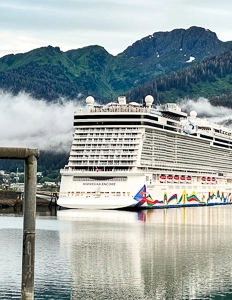
Quiz: Test Your Cruise Lingo Knowledge
Which term describes the first day of the cruise?
Disembarkation DaySea Day
Embarkation Day
Sailaway Day
What is the word for getting on a cruise ship?
The word for getting on a cruise ship is “embarkation.”
What are people on a cruise called?
People on a cruise are commonly referred to as “passengers” or “cruisers.” Virgin Voyages likes to call them “sailors.”
BEFORE YOU SET SAIL, HERE ARE SOME RELATED ARTICLES YOU DON’T WANT TO MISS:
Kathy Ava
Meet Kathy Ava, a food, travel, and cruise writer based in Los Angeles/Pasadena, and the owner and main writer of Tasty Itinerary. With over 20 years of experience planning trips and logistics at her full-time job and for herself, she's become a pro at crafting unforgettable tasty itineraries. She's always on the hunt for delicious, fun travel destinations and cruise itineraries. She firmly believes that life is short and we must make the most of it, so always say yes to dessert.
